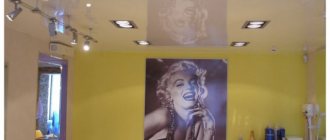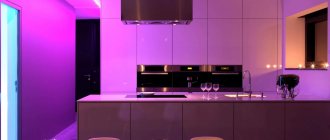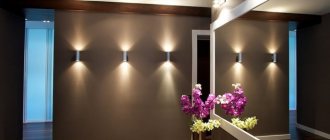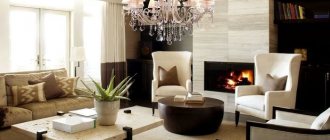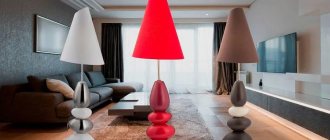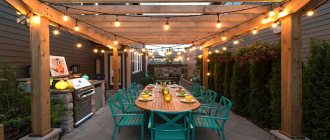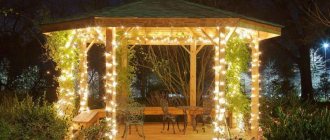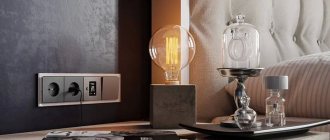Most people naively believe that in order to create a truly unique and inimitable interior, they will almost have to give their soul to the devil. Meanwhile, you can achieve originality using the basic tools that you have by default: the texture of the ceiling surface and lighting. The main thing is to use these trump cards correctly. If you have another hall renovation on the horizon, then our material today is akin to a lifesaver - we invite you to look at the photo of suspended ceilings in the hall with a chandelier and lamps. We have selected for you 50 interesting options in a wide variety of interiors, ranging from hackneyed but cute classics to mockingly bold and pompous art projects.
- Requirements for the ceiling in the hall;
- Advantages of using tension fabric;
- The relationship between fabric textures and light sources;
- Features of selecting the color of the ceiling for the type of lighting;
- Examples of the location of lamps and chandeliers;
- Photo of single-level ceilings;
- Photos of two-level and multi-level ceilings;
- Conclusion.
Requirements for the ceiling in the hall
The hall is also often called the living room
. And this is not an accident: very often guests are received in this room. All the more serious is the responsibility that rests on your shoulders - to create a cozy interior for everyone and an atmosphere conducive to natural communication.
In addition, in the evenings the whole family gathers in the hall, relaxes actively, watches television programs, or sits back and watches a movie on the home theater. Already based on this, we can draw a conclusion as logical as thunder after lightning: under no circumstances should we ignore the ceiling as one of the most effective tools of expression.
Taking into account the functional characteristics of the room, we tried to put together the basic requirements for how the ceiling in the room should look and what role it should play in the overall interior of the room:
- direct participation in the functional zoning of the room
-
with the help of organized lighting and texture features, you can make one or another accent, for example, highlight a play area with directional light or beautifully emphasize flowing curtains falling from a cornice fixed in a niche; - color balance
-
often in photos of suspended ceilings in a room with a chandelier and lamps you can see how the top literally suppresses the bottom of the room with an annoying color scheme - this is a mistake by the designer and is not allowed to be executed; - correction of visual defects
-
for example, excessive ceiling height and the resulting atmosphere of alienation can be corrected by finishing the surface in several levels
; - work to visually enrich the room
-
if the overall design of the room seems conservative, monotonous and boring to you, then with the help of the right color on the ceiling you can radically change the impression of the entire interior.
Lighting accents
Using lighting in the interior of a room, you can add some design accents.
Thus, LED strips are often used to emphasize the geometric shapes and contours of a room. They are attached using special double-sided tape. If you want to focus on the design of the lamp itself, then you can create an entire composition from several sources of non-standard shapes and bright colors. Spots are often used to complete the interior. For such structures, you can easily change the direction of location, which allows you to separately highlight different areas in the room (workplace, pieces of furniture).
Advantages of using tension fabric
In the photo, stretch ceilings in the hall always look advantageous, especially if you choose the right chandelier and lamps. This is not surprising: the full potential of PVC film
are revealed precisely in spacious rooms, adding maximum gloss, solemnity and nobility to the atmosphere.
All the advantages of using suspended ceilings in the hall are below:
- perfectly flat ceiling;
- the ability to hide traces of communications and wires;
- construction of complex and nonlinear multi-level structures;
- visual experiments with living space;
- expanding the color range of the room;
- combinations with other types of materials;
- use of mirror segments;
- unlimited possibilities of light integration.
Let us pay close attention to the last point - it is the interaction with light sources that allows you to profitably use all the advantages of a particular ceiling texture and create an extraordinary and memorable interior in the room.
Popular lamp manufacturers
There are dozens of items on the packages of light bulbs. Products of certain brands differ in the technologies used in production and in cost.
According to the rating compiled at the beginning of 2022, the top 5 best brands included Philips, Osram, Gauss, Feron, Camelion. Lamps from these manufacturers are reliable, have a long warranty period, and a high price. There are many models.
The top 10 is completed by ASD, Navigator, Jazzway, Era and Kosmos. Their light bulbs are distinguished by low prices, long service life, and availability. However, marriage is more common among them than among the leaders of the rating.
Features of choosing the color of the ceiling for the type of lighting
The right shade is akin to a successful poem written in a fit of inspiration. In the art of design, as in poetry: sometimes even combinations that are unfriendly to each other can give a stunning effect. However, they do not cancel the general rules known to everyone. After all, exceptions exist only to confirm them, right?
We have selected some useful tips for you that may well be useful if you do not know how best to reveal the advantages of a particular color in combination with the lighting of the lamps in the hall.
- intense lighting has the ability to greatly lighten the ceiling - therefore, avoid overly subtle and weakly expressed shades to avoid the unnecessary effect of a bleached surface;
- in low rooms, do not use a combination of a central chandelier with symmetrically located spotlights - this will cause an overloaded effect; it is best to choose a beautiful light color for the ceiling and make do with either one chandelier or spots located around the perimeter;
- LED strip successfully interacts with the shade of any temperature: remember this when you need to lighten or, conversely, darken the space a little;
- if the hall is located in the shady side of the house, choose warm shades as the main color of the ceiling and emphasize their influence using spotlights.
Recommendations for lighting design
Modern interior solutions combine several types of lighting to create a cozy atmosphere at any time of the day. To do this, LED lighting is built in, which creates a soft light and has many applications.
Along the perimeter
Installing an LED line along the walls is called contour lighting. It visually expands the space and creates the effect of a “floating ceiling”.
Inside
They equip the entire area of the canvas with illumination “from the inside” or create figures and drawings from LED strips, which, when turned on, convey an unusual design.
Starry sky
This effect is created in 2 ways:
- In the space behind the ceiling, light guide threads (fiber optics, needle elements) powered by a light generator are placed in a chaotic manner.
- LEDs illuminate the canvas depicting the starry sky.
Examples of the location of lamps and chandeliers
We offer you an excellent diagram that will help you correctly place spotlights around the chandelier in the hall and make the interior more comfortable and expressive.
Below is a photo of suspended ceilings in the hall with a chandelier and lamps in a variety of options.
Material of manufacture
Experts in the field of interior design are unanimous - the best material for a stretch ceiling in an apartment is PVC film with the addition of a plasticizer. As for classification, there are such types of ceilings as:
- mirror;
- glossy;
- matte;
- fabric (satin).
The first one is the most beautiful, but also very capricious. It is not easy to take care of it, because there should be no streaks on the mirror surface. Washing is possible only with soapy water; any abrasive substances cannot be used. But such ceilings visually expand the space, giving it additional height, depth and volume, which is extremely valuable in rooms with a small ceiling height, but spacious in area.
The same applies to gloss, however, such a canvas has its own specifics: if a mirror surface reflects everything clearly, then a glossy surface reflects blurryly, as if in a fog. Glossy ceilings look great in small living rooms, giving them an airy feel. The colors most often chosen for this type of design are light and neutral - white, milky, beige, coffee with milk, light gray. You can make the ceiling dark, but keep in mind that this may create discomfort for some people.
Matte canvases do not visually increase the height of the room, but they create an atmosphere of comfort and tranquility, and they also look very noble.
And fabric canvas is the best option for wooden houses. It is not advisable to use it in city apartments, since it is not airtight and is not protected from leakage.
Single-level ceilings
Single-level
suspended ceilings, reinforced with a chandelier and lamps as light sources, are the most common type of ceiling structure, usually in small rooms. Most often these are halls located in apartment buildings. Some will say that with such restrictions it is difficult to achieve an impressive result, but we will answer: not at all. And as proof, we suggest looking at the photo of single-level suspended ceilings in the hall with a complex lighting system - a central chandelier and lamps, where the owners managed to emphasize a wide range of color palette, volume and stylistic concept.
Nuances of choosing lighting depending on the texture of the canvas
When thinking about the design of a room, it is necessary to take into account the choice of lighting depending on the texture of the canvas. There are three main types of canvas:
- Glossy ceilings reflect light very well. They visually expand the room. Many interior items are reflected on the smooth surface of the ceiling. Horn chandeliers located face up are not suitable for such ceilings. In them, like in a mirror, the inside of the ceilings will be reflected, and glare from the lamps will be noticeable.
- Matte fabrics that imitate a painted surface practically do not reflect light. In this option, LED strips and turned lamps with a downward beam look inexpensive.
- The satin structure softly reflects and diffuses light, and the color tone can vary depending on the viewing angle. On such canvases a pleasant soft illumination with a pearlescent shimmer is formed.
For each texture, you can choose track lighting (here you can direct the flow in any direction) and light lines (at the same level as the ceiling)!
Two-level and multi-level ceilings
As a rule, they can most often be seen in a hall in the format of a country house, where each room has an adequate supply of square meters. However, sometimes exceptions happen.
Our small selection of photos of stretch ceilings with several levels in the hall with a chandelier and lamps in the hall. And you can see even more examples with stretch ceilings in the article: “Stretch two-level ceilings - 100 photos with the best ideas.”
Rules for installing lamps on polyvinyl tension structures
The qualities of vinyl that must be taken into account when installing lamps on the ceiling are:
- ability to stretch;
- predisposition of the material to drying out and cracking;
- the possibility of burnout due to the directed beam of too bright light;
- flammability of the fabric.
In order not only to decorate the living room with lamps, but also to be confident in your own safety, you need to follow a number of simple recommendations for installing lamps on suspended ceilings:
Remove all wires while still stretching the vinyl sheet across the ceiling. Lay cables in special corrugations or plastic channels. Use terminals, fuses and transformers to connect specific lamps, such as LEDs, fluorescent or halogen light sources. Install the chandelier horns so that the lamps in it are no closer than 15 cm from the tension fabric (this only applies to incandescent lamps, which heat up during operation). Do not mount heated light bulbs closer than 20 cm from the seams of the vinyl sheet. All lighting fixtures should be mounted on frames, and not attached directly to the canvas - even a small load will lead to stretching of the suspended ceiling and its subsequent sagging. Do not direct light rays directly at the ceiling to prevent the canvas from burning out (for lamps with a power of more than 50 W).
Stretch ceilings look very modern, but for greater effect it is necessary to choose the right lighting for them, which at the same time must be combined with all the interior details of the living room.
Connecting LED strip
Read how to choose a high-quality ribbon in a separate article.
To create a good luminous flux, it is recommended to choose a backlight with SMD 2835 crystals.
Don't confuse them with SMD 3528.
Unlike lighting for a floating ceiling, where 9.6 W/m is usually sufficient, select power from 14.4 W/m and above.
Pre-degrease the area where the LED tape will be applied.
Before installation, it would be a good idea to see if all the diodes are lit and if there are any defects. Simply put, check the functionality of the backlight.
If the total length is not enough, then you can solder and extend the backlight from several segments.
After soldering, apply voltage again and check if everything works.
The LED strip is applied very easily and simply. With one hand you peel off the bottom backing, and with the other you press it against the smooth surface of the profile.
The power wires are routed through a drilled hole at the very beginning of the light line.
Be sure to insulate the soldering areas of the conductors. This can be either heat shrink or just electrical tape.
If you have a wide light profile and want really full-fledged flood light, then it makes sense to stick the tape in two rows.
If the backlight is long enough (about 4-5m), it is recommended to power the tape from both sides. That is, the wires from the power source (+ and -) should come both to the beginning of the tape and to its end.
In this case, all diodes will shine equally. Otherwise, an unpleasant effect will appear when the light line on one side of the ceiling is brighter than on the other.
Levels
Tension ceiling installation systems allow you to install several levels. This option makes it possible not only to hide communications, but also to place multi-point lighting. But in the case of low ceilings, you should stick to a single-level placement so as not to reduce the height of the room even more.
For rooms with high ceilings, two-level and multi-level systems can be used. The first option is the most common, as it does not complicate the design too much and at the same time makes the room more original. This technique allows you to use canvases of different textures or colors, visually changing and enlarging the space.
Complex options with several levels can only be used in large living rooms.
